Health Advocacy Campaign Development Report: Public Health Concerns
VerifiedAdded on 2023/04/20
|13
|3849
|277
Report
AI Summary
This report delves into the development of a health advocacy campaign aimed at addressing public health concerns, specifically focusing on tobacco use among adolescents and the prevalence of diabetes in Kansas City. It examines the ethical dilemmas that may arise during such campaigns, referencing the ANA codes of ethics for nursing practices, and proposes strategies to resolve these dilemmas. The report highlights the relevant ethics and lobbying laws, including professional, grassroots, and political lobbying, crucial for the success of the campaign. It also discusses unique ethical challenges related to adolescent populations and those with diabetes, such as confidentiality, privacy, and autonomy, and suggests ways to mitigate these challenges. The paper concludes with a summary of the advocacy campaign, emphasizing its goal to reduce chronic diseases and raise awareness through social media platforms. This report provides a comprehensive overview of the complexities involved in health advocacy, offering insights into ethical considerations, legal frameworks, and practical strategies for improving public health outcomes.
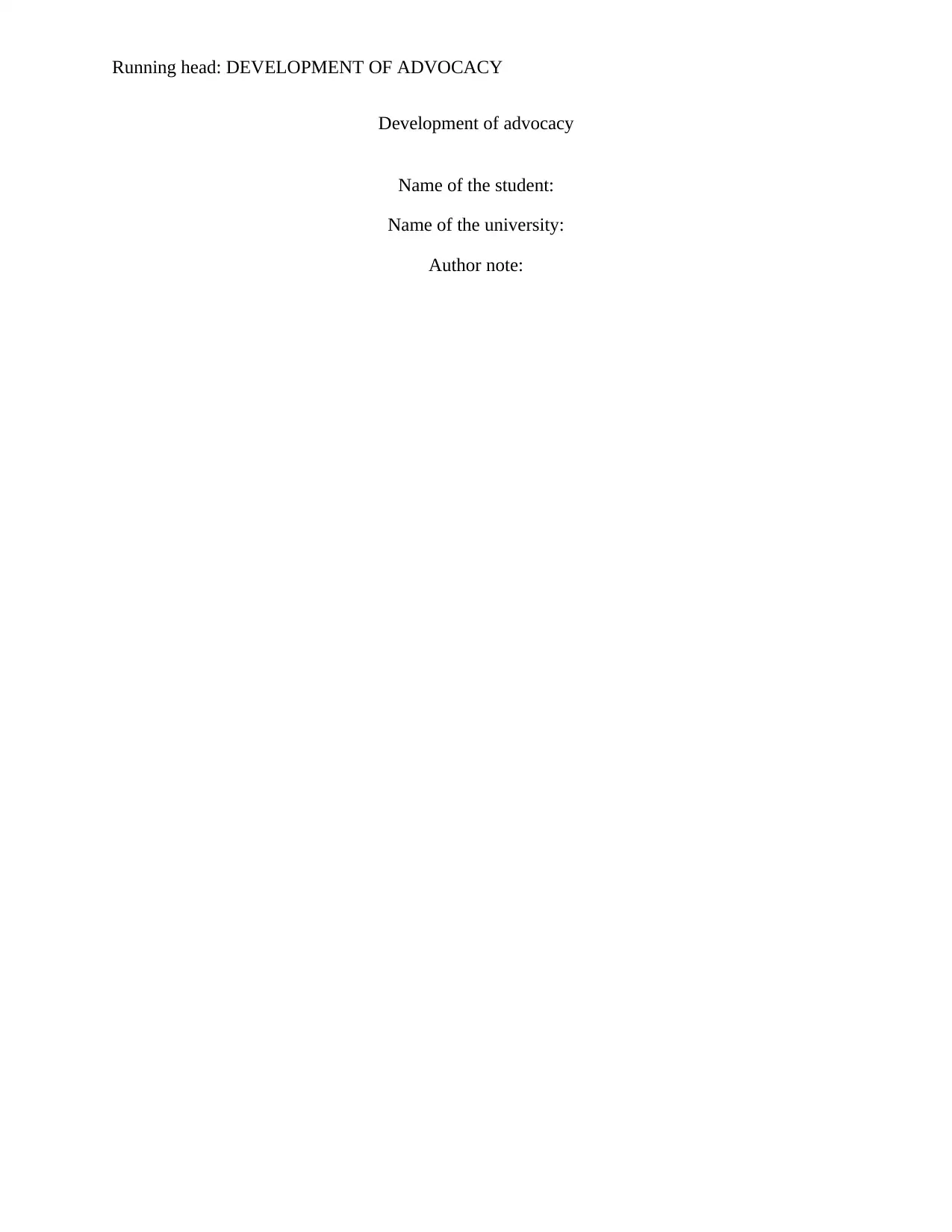
Running head: DEVELOPMENT OF ADVOCACY
Development of advocacy
Name of the student:
Name of the university:
Author note:
Development of advocacy
Name of the student:
Name of the university:
Author note:
Paraphrase This Document
Need a fresh take? Get an instant paraphrase of this document with our AI Paraphraser
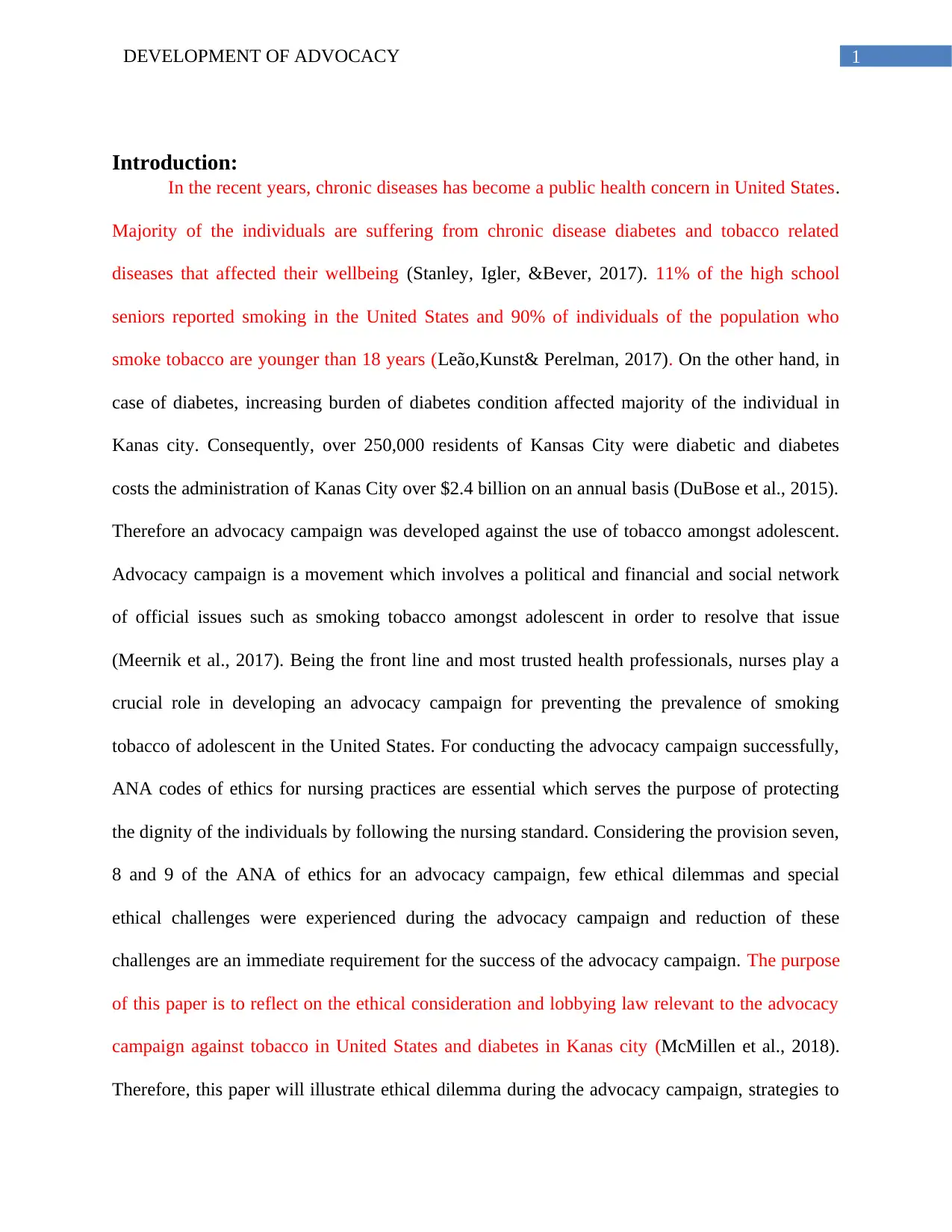
1DEVELOPMENT OF ADVOCACY
Introduction:
In the recent years, chronic diseases has become a public health concern in United States.
Majority of the individuals are suffering from chronic disease diabetes and tobacco related
diseases that affected their wellbeing (Stanley, Igler, &Bever, 2017). 11% of the high school
seniors reported smoking in the United States and 90% of individuals of the population who
smoke tobacco are younger than 18 years (Leão,Kunst& Perelman, 2017). On the other hand, in
case of diabetes, increasing burden of diabetes condition affected majority of the individual in
Kanas city. Consequently, over 250,000 residents of Kansas City were diabetic and diabetes
costs the administration of Kanas City over $2.4 billion on an annual basis (DuBose et al., 2015).
Therefore an advocacy campaign was developed against the use of tobacco amongst adolescent.
Advocacy campaign is a movement which involves a political and financial and social network
of official issues such as smoking tobacco amongst adolescent in order to resolve that issue
(Meernik et al., 2017). Being the front line and most trusted health professionals, nurses play a
crucial role in developing an advocacy campaign for preventing the prevalence of smoking
tobacco of adolescent in the United States. For conducting the advocacy campaign successfully,
ANA codes of ethics for nursing practices are essential which serves the purpose of protecting
the dignity of the individuals by following the nursing standard. Considering the provision seven,
8 and 9 of the ANA of ethics for an advocacy campaign, few ethical dilemmas and special
ethical challenges were experienced during the advocacy campaign and reduction of these
challenges are an immediate requirement for the success of the advocacy campaign. The purpose
of this paper is to reflect on the ethical consideration and lobbying law relevant to the advocacy
campaign against tobacco in United States and diabetes in Kanas city (McMillen et al., 2018).
Therefore, this paper will illustrate ethical dilemma during the advocacy campaign, strategies to
Introduction:
In the recent years, chronic diseases has become a public health concern in United States.
Majority of the individuals are suffering from chronic disease diabetes and tobacco related
diseases that affected their wellbeing (Stanley, Igler, &Bever, 2017). 11% of the high school
seniors reported smoking in the United States and 90% of individuals of the population who
smoke tobacco are younger than 18 years (Leão,Kunst& Perelman, 2017). On the other hand, in
case of diabetes, increasing burden of diabetes condition affected majority of the individual in
Kanas city. Consequently, over 250,000 residents of Kansas City were diabetic and diabetes
costs the administration of Kanas City over $2.4 billion on an annual basis (DuBose et al., 2015).
Therefore an advocacy campaign was developed against the use of tobacco amongst adolescent.
Advocacy campaign is a movement which involves a political and financial and social network
of official issues such as smoking tobacco amongst adolescent in order to resolve that issue
(Meernik et al., 2017). Being the front line and most trusted health professionals, nurses play a
crucial role in developing an advocacy campaign for preventing the prevalence of smoking
tobacco of adolescent in the United States. For conducting the advocacy campaign successfully,
ANA codes of ethics for nursing practices are essential which serves the purpose of protecting
the dignity of the individuals by following the nursing standard. Considering the provision seven,
8 and 9 of the ANA of ethics for an advocacy campaign, few ethical dilemmas and special
ethical challenges were experienced during the advocacy campaign and reduction of these
challenges are an immediate requirement for the success of the advocacy campaign. The purpose
of this paper is to reflect on the ethical consideration and lobbying law relevant to the advocacy
campaign against tobacco in United States and diabetes in Kanas city (McMillen et al., 2018).
Therefore, this paper will illustrate ethical dilemma during the advocacy campaign, strategies to
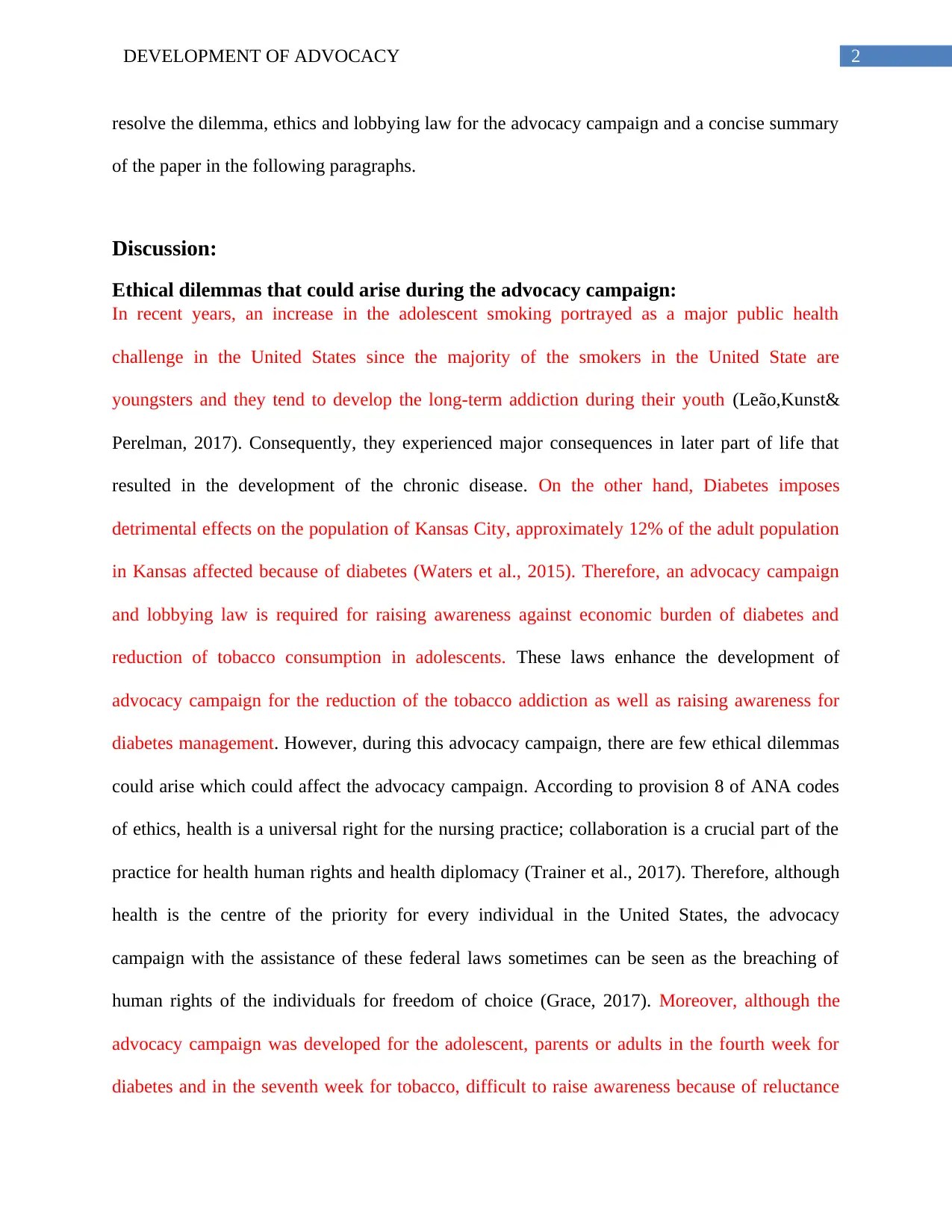
2DEVELOPMENT OF ADVOCACY
resolve the dilemma, ethics and lobbying law for the advocacy campaign and a concise summary
of the paper in the following paragraphs.
Discussion:
Ethical dilemmas that could arise during the advocacy campaign:
In recent years, an increase in the adolescent smoking portrayed as a major public health
challenge in the United States since the majority of the smokers in the United State are
youngsters and they tend to develop the long-term addiction during their youth (Leão,Kunst&
Perelman, 2017). Consequently, they experienced major consequences in later part of life that
resulted in the development of the chronic disease. On the other hand, Diabetes imposes
detrimental effects on the population of Kansas City, approximately 12% of the adult population
in Kansas affected because of diabetes (Waters et al., 2015). Therefore, an advocacy campaign
and lobbying law is required for raising awareness against economic burden of diabetes and
reduction of tobacco consumption in adolescents. These laws enhance the development of
advocacy campaign for the reduction of the tobacco addiction as well as raising awareness for
diabetes management. However, during this advocacy campaign, there are few ethical dilemmas
could arise which could affect the advocacy campaign. According to provision 8 of ANA codes
of ethics, health is a universal right for the nursing practice; collaboration is a crucial part of the
practice for health human rights and health diplomacy (Trainer et al., 2017). Therefore, although
health is the centre of the priority for every individual in the United States, the advocacy
campaign with the assistance of these federal laws sometimes can be seen as the breaching of
human rights of the individuals for freedom of choice (Grace, 2017). Moreover, although the
advocacy campaign was developed for the adolescent, parents or adults in the fourth week for
diabetes and in the seventh week for tobacco, difficult to raise awareness because of reluctance
resolve the dilemma, ethics and lobbying law for the advocacy campaign and a concise summary
of the paper in the following paragraphs.
Discussion:
Ethical dilemmas that could arise during the advocacy campaign:
In recent years, an increase in the adolescent smoking portrayed as a major public health
challenge in the United States since the majority of the smokers in the United State are
youngsters and they tend to develop the long-term addiction during their youth (Leão,Kunst&
Perelman, 2017). Consequently, they experienced major consequences in later part of life that
resulted in the development of the chronic disease. On the other hand, Diabetes imposes
detrimental effects on the population of Kansas City, approximately 12% of the adult population
in Kansas affected because of diabetes (Waters et al., 2015). Therefore, an advocacy campaign
and lobbying law is required for raising awareness against economic burden of diabetes and
reduction of tobacco consumption in adolescents. These laws enhance the development of
advocacy campaign for the reduction of the tobacco addiction as well as raising awareness for
diabetes management. However, during this advocacy campaign, there are few ethical dilemmas
could arise which could affect the advocacy campaign. According to provision 8 of ANA codes
of ethics, health is a universal right for the nursing practice; collaboration is a crucial part of the
practice for health human rights and health diplomacy (Trainer et al., 2017). Therefore, although
health is the centre of the priority for every individual in the United States, the advocacy
campaign with the assistance of these federal laws sometimes can be seen as the breaching of
human rights of the individuals for freedom of choice (Grace, 2017). Moreover, although the
advocacy campaign was developed for the adolescent, parents or adults in the fourth week for
diabetes and in the seventh week for tobacco, difficult to raise awareness because of reluctance
⊘ This is a preview!⊘
Do you want full access?
Subscribe today to unlock all pages.

Trusted by 1+ million students worldwide
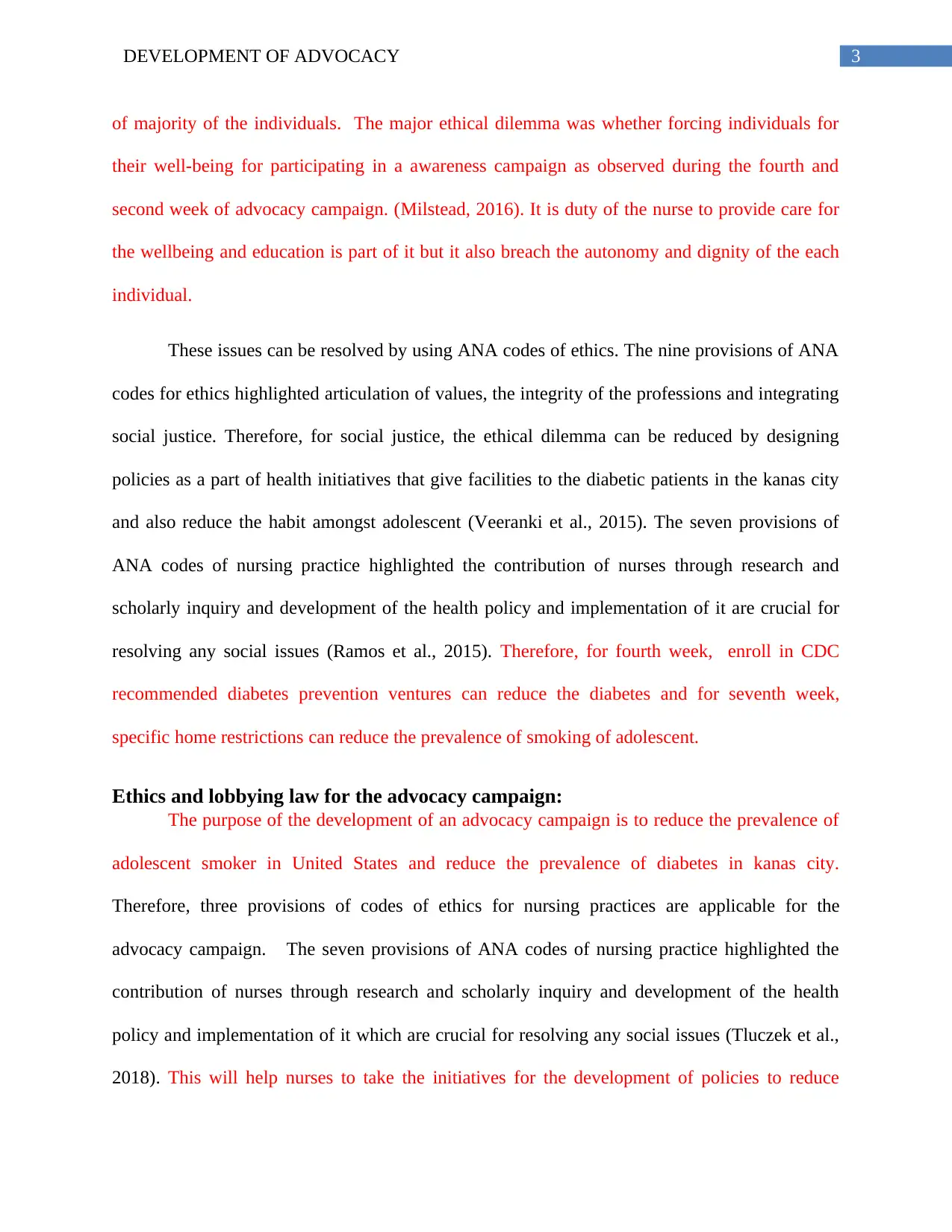
3DEVELOPMENT OF ADVOCACY
of majority of the individuals. The major ethical dilemma was whether forcing individuals for
their well-being for participating in a awareness campaign as observed during the fourth and
second week of advocacy campaign. (Milstead, 2016). It is duty of the nurse to provide care for
the wellbeing and education is part of it but it also breach the autonomy and dignity of the each
individual.
These issues can be resolved by using ANA codes of ethics. The nine provisions of ANA
codes for ethics highlighted articulation of values, the integrity of the professions and integrating
social justice. Therefore, for social justice, the ethical dilemma can be reduced by designing
policies as a part of health initiatives that give facilities to the diabetic patients in the kanas city
and also reduce the habit amongst adolescent (Veeranki et al., 2015). The seven provisions of
ANA codes of nursing practice highlighted the contribution of nurses through research and
scholarly inquiry and development of the health policy and implementation of it are crucial for
resolving any social issues (Ramos et al., 2015). Therefore, for fourth week, enroll in CDC
recommended diabetes prevention ventures can reduce the diabetes and for seventh week,
specific home restrictions can reduce the prevalence of smoking of adolescent.
Ethics and lobbying law for the advocacy campaign:
The purpose of the development of an advocacy campaign is to reduce the prevalence of
adolescent smoker in United States and reduce the prevalence of diabetes in kanas city.
Therefore, three provisions of codes of ethics for nursing practices are applicable for the
advocacy campaign. The seven provisions of ANA codes of nursing practice highlighted the
contribution of nurses through research and scholarly inquiry and development of the health
policy and implementation of it which are crucial for resolving any social issues (Tluczek et al.,
2018). This will help nurses to take the initiatives for the development of policies to reduce
of majority of the individuals. The major ethical dilemma was whether forcing individuals for
their well-being for participating in a awareness campaign as observed during the fourth and
second week of advocacy campaign. (Milstead, 2016). It is duty of the nurse to provide care for
the wellbeing and education is part of it but it also breach the autonomy and dignity of the each
individual.
These issues can be resolved by using ANA codes of ethics. The nine provisions of ANA
codes for ethics highlighted articulation of values, the integrity of the professions and integrating
social justice. Therefore, for social justice, the ethical dilemma can be reduced by designing
policies as a part of health initiatives that give facilities to the diabetic patients in the kanas city
and also reduce the habit amongst adolescent (Veeranki et al., 2015). The seven provisions of
ANA codes of nursing practice highlighted the contribution of nurses through research and
scholarly inquiry and development of the health policy and implementation of it are crucial for
resolving any social issues (Ramos et al., 2015). Therefore, for fourth week, enroll in CDC
recommended diabetes prevention ventures can reduce the diabetes and for seventh week,
specific home restrictions can reduce the prevalence of smoking of adolescent.
Ethics and lobbying law for the advocacy campaign:
The purpose of the development of an advocacy campaign is to reduce the prevalence of
adolescent smoker in United States and reduce the prevalence of diabetes in kanas city.
Therefore, three provisions of codes of ethics for nursing practices are applicable for the
advocacy campaign. The seven provisions of ANA codes of nursing practice highlighted the
contribution of nurses through research and scholarly inquiry and development of the health
policy and implementation of it which are crucial for resolving any social issues (Tluczek et al.,
2018). This will help nurses to take the initiatives for the development of policies to reduce
Paraphrase This Document
Need a fresh take? Get an instant paraphrase of this document with our AI Paraphraser
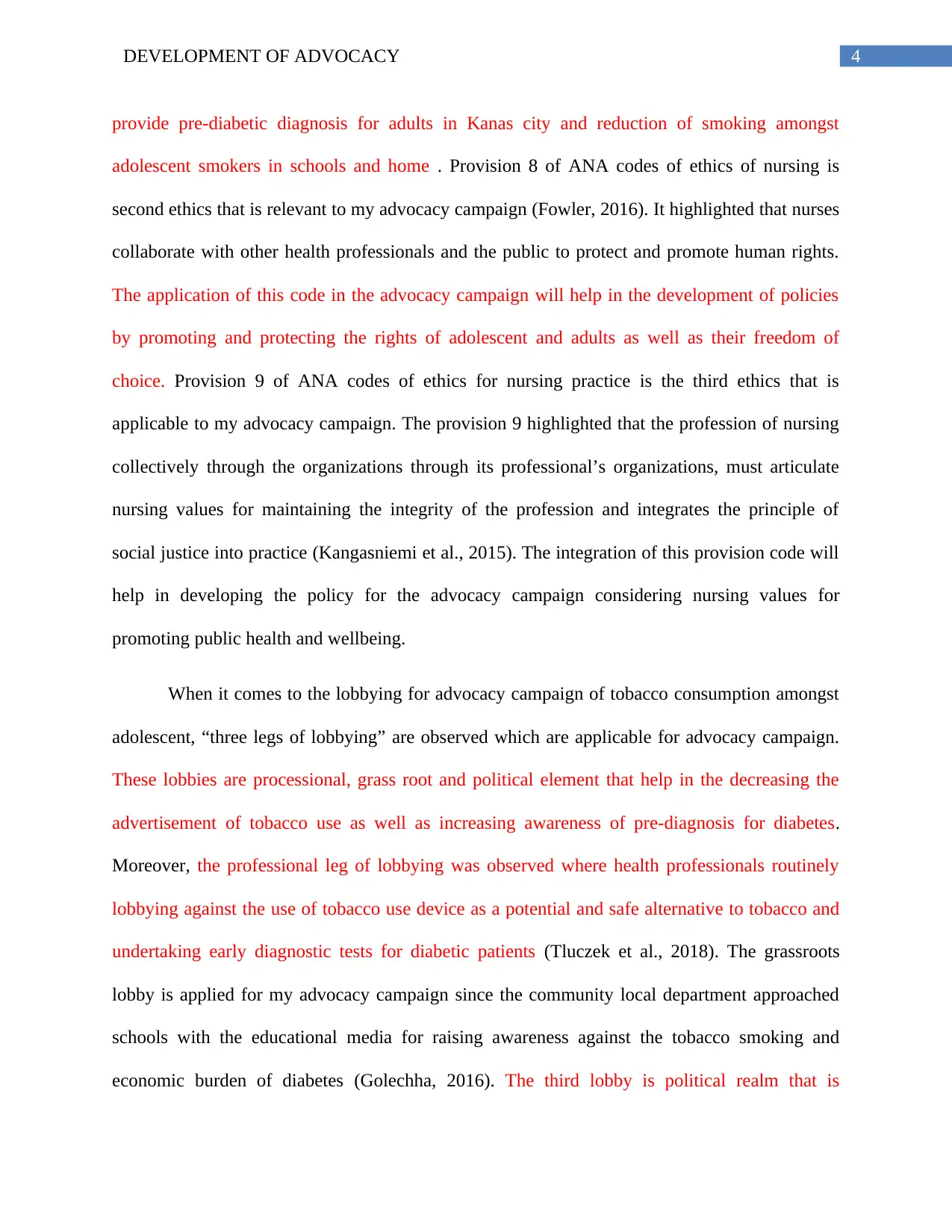
4DEVELOPMENT OF ADVOCACY
provide pre-diabetic diagnosis for adults in Kanas city and reduction of smoking amongst
adolescent smokers in schools and home . Provision 8 of ANA codes of ethics of nursing is
second ethics that is relevant to my advocacy campaign (Fowler, 2016). It highlighted that nurses
collaborate with other health professionals and the public to protect and promote human rights.
The application of this code in the advocacy campaign will help in the development of policies
by promoting and protecting the rights of adolescent and adults as well as their freedom of
choice. Provision 9 of ANA codes of ethics for nursing practice is the third ethics that is
applicable to my advocacy campaign. The provision 9 highlighted that the profession of nursing
collectively through the organizations through its professional’s organizations, must articulate
nursing values for maintaining the integrity of the profession and integrates the principle of
social justice into practice (Kangasniemi et al., 2015). The integration of this provision code will
help in developing the policy for the advocacy campaign considering nursing values for
promoting public health and wellbeing.
When it comes to the lobbying for advocacy campaign of tobacco consumption amongst
adolescent, “three legs of lobbying” are observed which are applicable for advocacy campaign.
These lobbies are processional, grass root and political element that help in the decreasing the
advertisement of tobacco use as well as increasing awareness of pre-diagnosis for diabetes.
Moreover, the professional leg of lobbying was observed where health professionals routinely
lobbying against the use of tobacco use device as a potential and safe alternative to tobacco and
undertaking early diagnostic tests for diabetic patients (Tluczek et al., 2018). The grassroots
lobby is applied for my advocacy campaign since the community local department approached
schools with the educational media for raising awareness against the tobacco smoking and
economic burden of diabetes (Golechha, 2016). The third lobby is political realm that is
provide pre-diabetic diagnosis for adults in Kanas city and reduction of smoking amongst
adolescent smokers in schools and home . Provision 8 of ANA codes of ethics of nursing is
second ethics that is relevant to my advocacy campaign (Fowler, 2016). It highlighted that nurses
collaborate with other health professionals and the public to protect and promote human rights.
The application of this code in the advocacy campaign will help in the development of policies
by promoting and protecting the rights of adolescent and adults as well as their freedom of
choice. Provision 9 of ANA codes of ethics for nursing practice is the third ethics that is
applicable to my advocacy campaign. The provision 9 highlighted that the profession of nursing
collectively through the organizations through its professional’s organizations, must articulate
nursing values for maintaining the integrity of the profession and integrates the principle of
social justice into practice (Kangasniemi et al., 2015). The integration of this provision code will
help in developing the policy for the advocacy campaign considering nursing values for
promoting public health and wellbeing.
When it comes to the lobbying for advocacy campaign of tobacco consumption amongst
adolescent, “three legs of lobbying” are observed which are applicable for advocacy campaign.
These lobbies are processional, grass root and political element that help in the decreasing the
advertisement of tobacco use as well as increasing awareness of pre-diagnosis for diabetes.
Moreover, the professional leg of lobbying was observed where health professionals routinely
lobbying against the use of tobacco use device as a potential and safe alternative to tobacco and
undertaking early diagnostic tests for diabetic patients (Tluczek et al., 2018). The grassroots
lobby is applied for my advocacy campaign since the community local department approached
schools with the educational media for raising awareness against the tobacco smoking and
economic burden of diabetes (Golechha, 2016). The third lobby is political realm that is
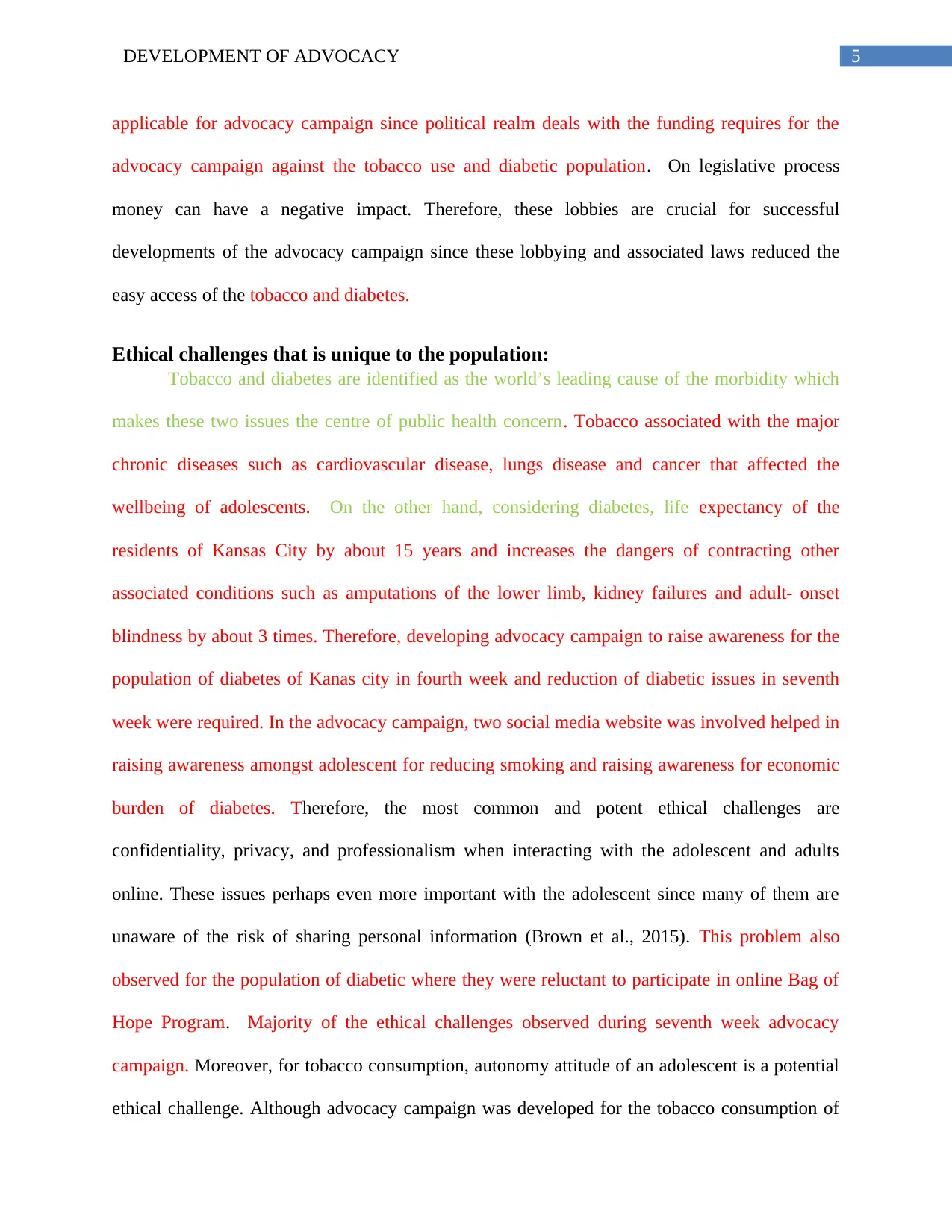
5DEVELOPMENT OF ADVOCACY
applicable for advocacy campaign since political realm deals with the funding requires for the
advocacy campaign against the tobacco use and diabetic population. On legislative process
money can have a negative impact. Therefore, these lobbies are crucial for successful
developments of the advocacy campaign since these lobbying and associated laws reduced the
easy access of the tobacco and diabetes.
Ethical challenges that is unique to the population:
Tobacco and diabetes are identified as the world’s leading cause of the morbidity which
makes these two issues the centre of public health concern. Tobacco associated with the major
chronic diseases such as cardiovascular disease, lungs disease and cancer that affected the
wellbeing of adolescents. On the other hand, considering diabetes, life expectancy of the
residents of Kansas City by about 15 years and increases the dangers of contracting other
associated conditions such as amputations of the lower limb, kidney failures and adult- onset
blindness by about 3 times. Therefore, developing advocacy campaign to raise awareness for the
population of diabetes of Kanas city in fourth week and reduction of diabetic issues in seventh
week were required. In the advocacy campaign, two social media website was involved helped in
raising awareness amongst adolescent for reducing smoking and raising awareness for economic
burden of diabetes. Therefore, the most common and potent ethical challenges are
confidentiality, privacy, and professionalism when interacting with the adolescent and adults
online. These issues perhaps even more important with the adolescent since many of them are
unaware of the risk of sharing personal information (Brown et al., 2015). This problem also
observed for the population of diabetic where they were reluctant to participate in online Bag of
Hope Program. Majority of the ethical challenges observed during seventh week advocacy
campaign. Moreover, for tobacco consumption, autonomy attitude of an adolescent is a potential
ethical challenge. Although advocacy campaign was developed for the tobacco consumption of
applicable for advocacy campaign since political realm deals with the funding requires for the
advocacy campaign against the tobacco use and diabetic population. On legislative process
money can have a negative impact. Therefore, these lobbies are crucial for successful
developments of the advocacy campaign since these lobbying and associated laws reduced the
easy access of the tobacco and diabetes.
Ethical challenges that is unique to the population:
Tobacco and diabetes are identified as the world’s leading cause of the morbidity which
makes these two issues the centre of public health concern. Tobacco associated with the major
chronic diseases such as cardiovascular disease, lungs disease and cancer that affected the
wellbeing of adolescents. On the other hand, considering diabetes, life expectancy of the
residents of Kansas City by about 15 years and increases the dangers of contracting other
associated conditions such as amputations of the lower limb, kidney failures and adult- onset
blindness by about 3 times. Therefore, developing advocacy campaign to raise awareness for the
population of diabetes of Kanas city in fourth week and reduction of diabetic issues in seventh
week were required. In the advocacy campaign, two social media website was involved helped in
raising awareness amongst adolescent for reducing smoking and raising awareness for economic
burden of diabetes. Therefore, the most common and potent ethical challenges are
confidentiality, privacy, and professionalism when interacting with the adolescent and adults
online. These issues perhaps even more important with the adolescent since many of them are
unaware of the risk of sharing personal information (Brown et al., 2015). This problem also
observed for the population of diabetic where they were reluctant to participate in online Bag of
Hope Program. Majority of the ethical challenges observed during seventh week advocacy
campaign. Moreover, for tobacco consumption, autonomy attitude of an adolescent is a potential
ethical challenge. Although advocacy campaign was developed for the tobacco consumption of
⊘ This is a preview!⊘
Do you want full access?
Subscribe today to unlock all pages.

Trusted by 1+ million students worldwide
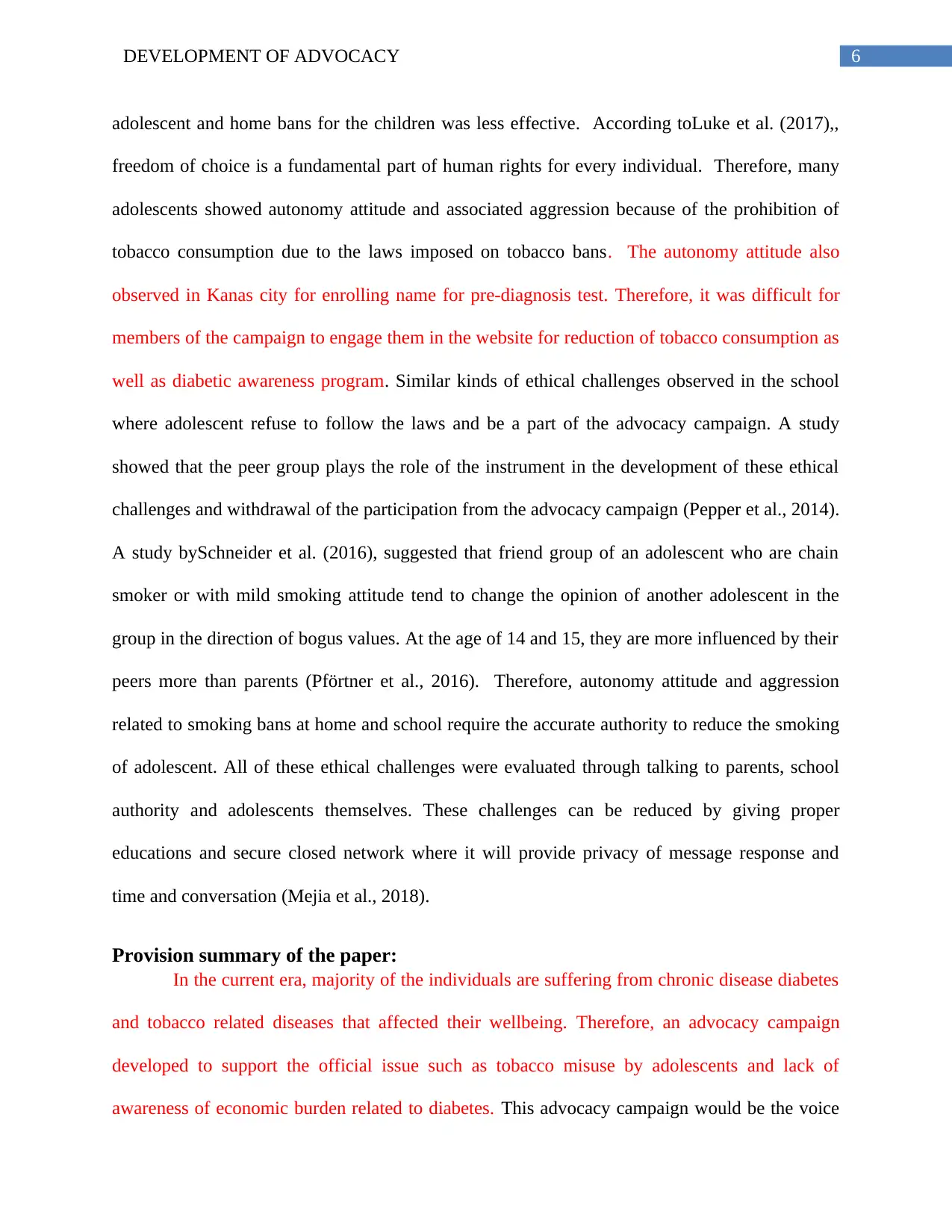
6DEVELOPMENT OF ADVOCACY
adolescent and home bans for the children was less effective. According toLuke et al. (2017),,
freedom of choice is a fundamental part of human rights for every individual. Therefore, many
adolescents showed autonomy attitude and associated aggression because of the prohibition of
tobacco consumption due to the laws imposed on tobacco bans. The autonomy attitude also
observed in Kanas city for enrolling name for pre-diagnosis test. Therefore, it was difficult for
members of the campaign to engage them in the website for reduction of tobacco consumption as
well as diabetic awareness program. Similar kinds of ethical challenges observed in the school
where adolescent refuse to follow the laws and be a part of the advocacy campaign. A study
showed that the peer group plays the role of the instrument in the development of these ethical
challenges and withdrawal of the participation from the advocacy campaign (Pepper et al., 2014).
A study bySchneider et al. (2016), suggested that friend group of an adolescent who are chain
smoker or with mild smoking attitude tend to change the opinion of another adolescent in the
group in the direction of bogus values. At the age of 14 and 15, they are more influenced by their
peers more than parents (Pförtner et al., 2016). Therefore, autonomy attitude and aggression
related to smoking bans at home and school require the accurate authority to reduce the smoking
of adolescent. All of these ethical challenges were evaluated through talking to parents, school
authority and adolescents themselves. These challenges can be reduced by giving proper
educations and secure closed network where it will provide privacy of message response and
time and conversation (Mejia et al., 2018).
Provision summary of the paper:
In the current era, majority of the individuals are suffering from chronic disease diabetes
and tobacco related diseases that affected their wellbeing. Therefore, an advocacy campaign
developed to support the official issue such as tobacco misuse by adolescents and lack of
awareness of economic burden related to diabetes. This advocacy campaign would be the voice
adolescent and home bans for the children was less effective. According toLuke et al. (2017),,
freedom of choice is a fundamental part of human rights for every individual. Therefore, many
adolescents showed autonomy attitude and associated aggression because of the prohibition of
tobacco consumption due to the laws imposed on tobacco bans. The autonomy attitude also
observed in Kanas city for enrolling name for pre-diagnosis test. Therefore, it was difficult for
members of the campaign to engage them in the website for reduction of tobacco consumption as
well as diabetic awareness program. Similar kinds of ethical challenges observed in the school
where adolescent refuse to follow the laws and be a part of the advocacy campaign. A study
showed that the peer group plays the role of the instrument in the development of these ethical
challenges and withdrawal of the participation from the advocacy campaign (Pepper et al., 2014).
A study bySchneider et al. (2016), suggested that friend group of an adolescent who are chain
smoker or with mild smoking attitude tend to change the opinion of another adolescent in the
group in the direction of bogus values. At the age of 14 and 15, they are more influenced by their
peers more than parents (Pförtner et al., 2016). Therefore, autonomy attitude and aggression
related to smoking bans at home and school require the accurate authority to reduce the smoking
of adolescent. All of these ethical challenges were evaluated through talking to parents, school
authority and adolescents themselves. These challenges can be reduced by giving proper
educations and secure closed network where it will provide privacy of message response and
time and conversation (Mejia et al., 2018).
Provision summary of the paper:
In the current era, majority of the individuals are suffering from chronic disease diabetes
and tobacco related diseases that affected their wellbeing. Therefore, an advocacy campaign
developed to support the official issue such as tobacco misuse by adolescents and lack of
awareness of economic burden related to diabetes. This advocacy campaign would be the voice
Paraphrase This Document
Need a fresh take? Get an instant paraphrase of this document with our AI Paraphraser
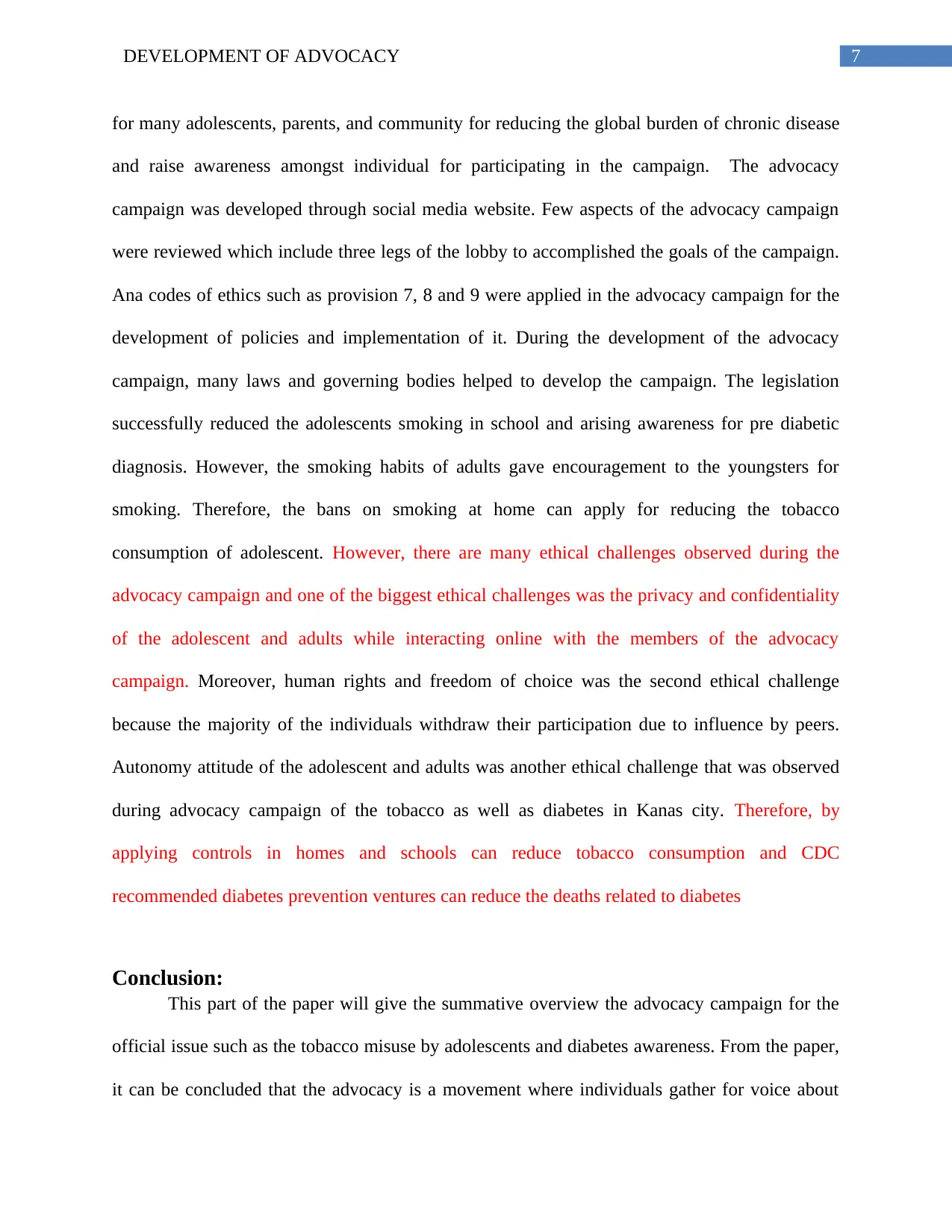
7DEVELOPMENT OF ADVOCACY
for many adolescents, parents, and community for reducing the global burden of chronic disease
and raise awareness amongst individual for participating in the campaign. The advocacy
campaign was developed through social media website. Few aspects of the advocacy campaign
were reviewed which include three legs of the lobby to accomplished the goals of the campaign.
Ana codes of ethics such as provision 7, 8 and 9 were applied in the advocacy campaign for the
development of policies and implementation of it. During the development of the advocacy
campaign, many laws and governing bodies helped to develop the campaign. The legislation
successfully reduced the adolescents smoking in school and arising awareness for pre diabetic
diagnosis. However, the smoking habits of adults gave encouragement to the youngsters for
smoking. Therefore, the bans on smoking at home can apply for reducing the tobacco
consumption of adolescent. However, there are many ethical challenges observed during the
advocacy campaign and one of the biggest ethical challenges was the privacy and confidentiality
of the adolescent and adults while interacting online with the members of the advocacy
campaign. Moreover, human rights and freedom of choice was the second ethical challenge
because the majority of the individuals withdraw their participation due to influence by peers.
Autonomy attitude of the adolescent and adults was another ethical challenge that was observed
during advocacy campaign of the tobacco as well as diabetes in Kanas city. Therefore, by
applying controls in homes and schools can reduce tobacco consumption and CDC
recommended diabetes prevention ventures can reduce the deaths related to diabetes
Conclusion:
This part of the paper will give the summative overview the advocacy campaign for the
official issue such as the tobacco misuse by adolescents and diabetes awareness. From the paper,
it can be concluded that the advocacy is a movement where individuals gather for voice about
for many adolescents, parents, and community for reducing the global burden of chronic disease
and raise awareness amongst individual for participating in the campaign. The advocacy
campaign was developed through social media website. Few aspects of the advocacy campaign
were reviewed which include three legs of the lobby to accomplished the goals of the campaign.
Ana codes of ethics such as provision 7, 8 and 9 were applied in the advocacy campaign for the
development of policies and implementation of it. During the development of the advocacy
campaign, many laws and governing bodies helped to develop the campaign. The legislation
successfully reduced the adolescents smoking in school and arising awareness for pre diabetic
diagnosis. However, the smoking habits of adults gave encouragement to the youngsters for
smoking. Therefore, the bans on smoking at home can apply for reducing the tobacco
consumption of adolescent. However, there are many ethical challenges observed during the
advocacy campaign and one of the biggest ethical challenges was the privacy and confidentiality
of the adolescent and adults while interacting online with the members of the advocacy
campaign. Moreover, human rights and freedom of choice was the second ethical challenge
because the majority of the individuals withdraw their participation due to influence by peers.
Autonomy attitude of the adolescent and adults was another ethical challenge that was observed
during advocacy campaign of the tobacco as well as diabetes in Kanas city. Therefore, by
applying controls in homes and schools can reduce tobacco consumption and CDC
recommended diabetes prevention ventures can reduce the deaths related to diabetes
Conclusion:
This part of the paper will give the summative overview the advocacy campaign for the
official issue such as the tobacco misuse by adolescents and diabetes awareness. From the paper,
it can be concluded that the advocacy is a movement where individuals gather for voice about
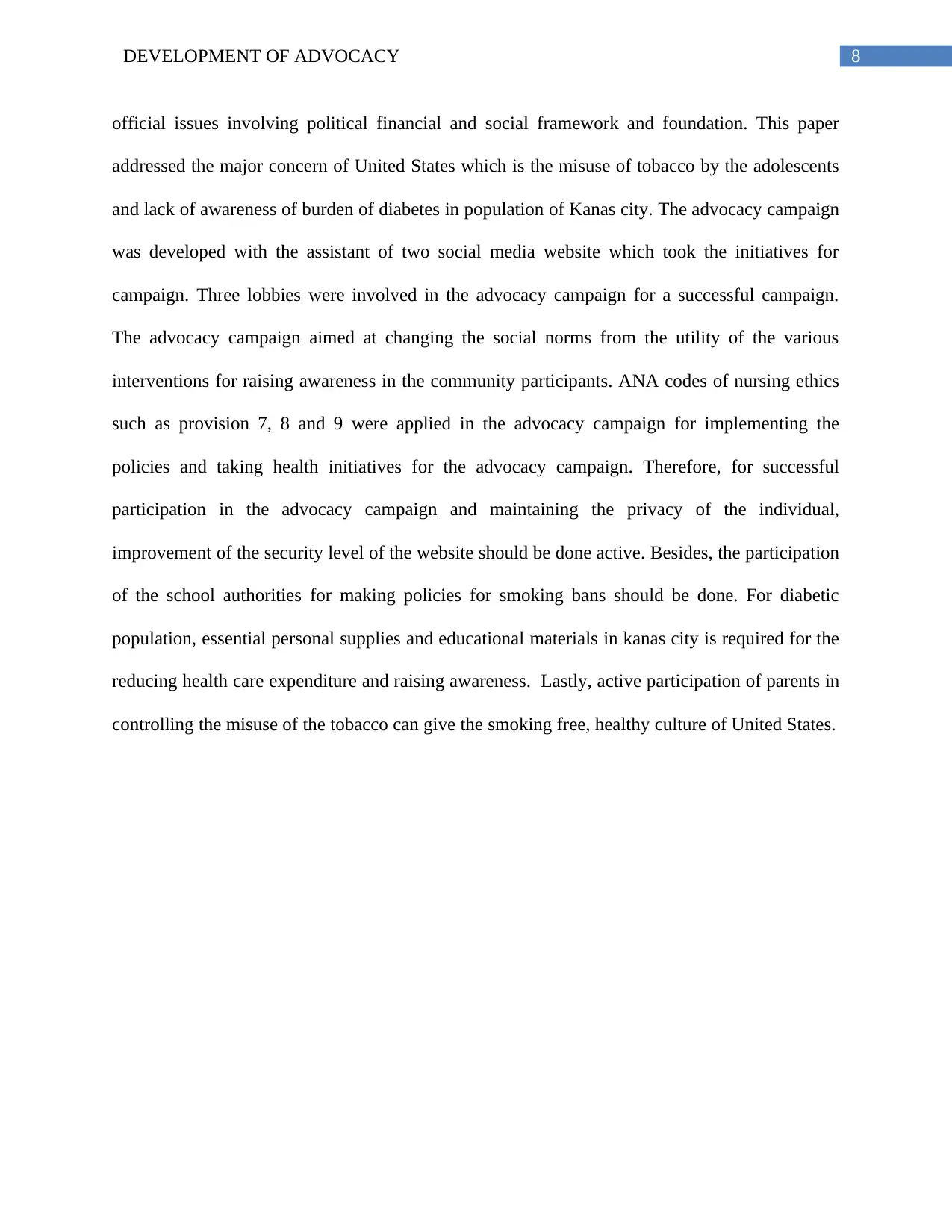
8DEVELOPMENT OF ADVOCACY
official issues involving political financial and social framework and foundation. This paper
addressed the major concern of United States which is the misuse of tobacco by the adolescents
and lack of awareness of burden of diabetes in population of Kanas city. The advocacy campaign
was developed with the assistant of two social media website which took the initiatives for
campaign. Three lobbies were involved in the advocacy campaign for a successful campaign.
The advocacy campaign aimed at changing the social norms from the utility of the various
interventions for raising awareness in the community participants. ANA codes of nursing ethics
such as provision 7, 8 and 9 were applied in the advocacy campaign for implementing the
policies and taking health initiatives for the advocacy campaign. Therefore, for successful
participation in the advocacy campaign and maintaining the privacy of the individual,
improvement of the security level of the website should be done active. Besides, the participation
of the school authorities for making policies for smoking bans should be done. For diabetic
population, essential personal supplies and educational materials in kanas city is required for the
reducing health care expenditure and raising awareness. Lastly, active participation of parents in
controlling the misuse of the tobacco can give the smoking free, healthy culture of United States.
official issues involving political financial and social framework and foundation. This paper
addressed the major concern of United States which is the misuse of tobacco by the adolescents
and lack of awareness of burden of diabetes in population of Kanas city. The advocacy campaign
was developed with the assistant of two social media website which took the initiatives for
campaign. Three lobbies were involved in the advocacy campaign for a successful campaign.
The advocacy campaign aimed at changing the social norms from the utility of the various
interventions for raising awareness in the community participants. ANA codes of nursing ethics
such as provision 7, 8 and 9 were applied in the advocacy campaign for implementing the
policies and taking health initiatives for the advocacy campaign. Therefore, for successful
participation in the advocacy campaign and maintaining the privacy of the individual,
improvement of the security level of the website should be done active. Besides, the participation
of the school authorities for making policies for smoking bans should be done. For diabetic
population, essential personal supplies and educational materials in kanas city is required for the
reducing health care expenditure and raising awareness. Lastly, active participation of parents in
controlling the misuse of the tobacco can give the smoking free, healthy culture of United States.
⊘ This is a preview!⊘
Do you want full access?
Subscribe today to unlock all pages.

Trusted by 1+ million students worldwide
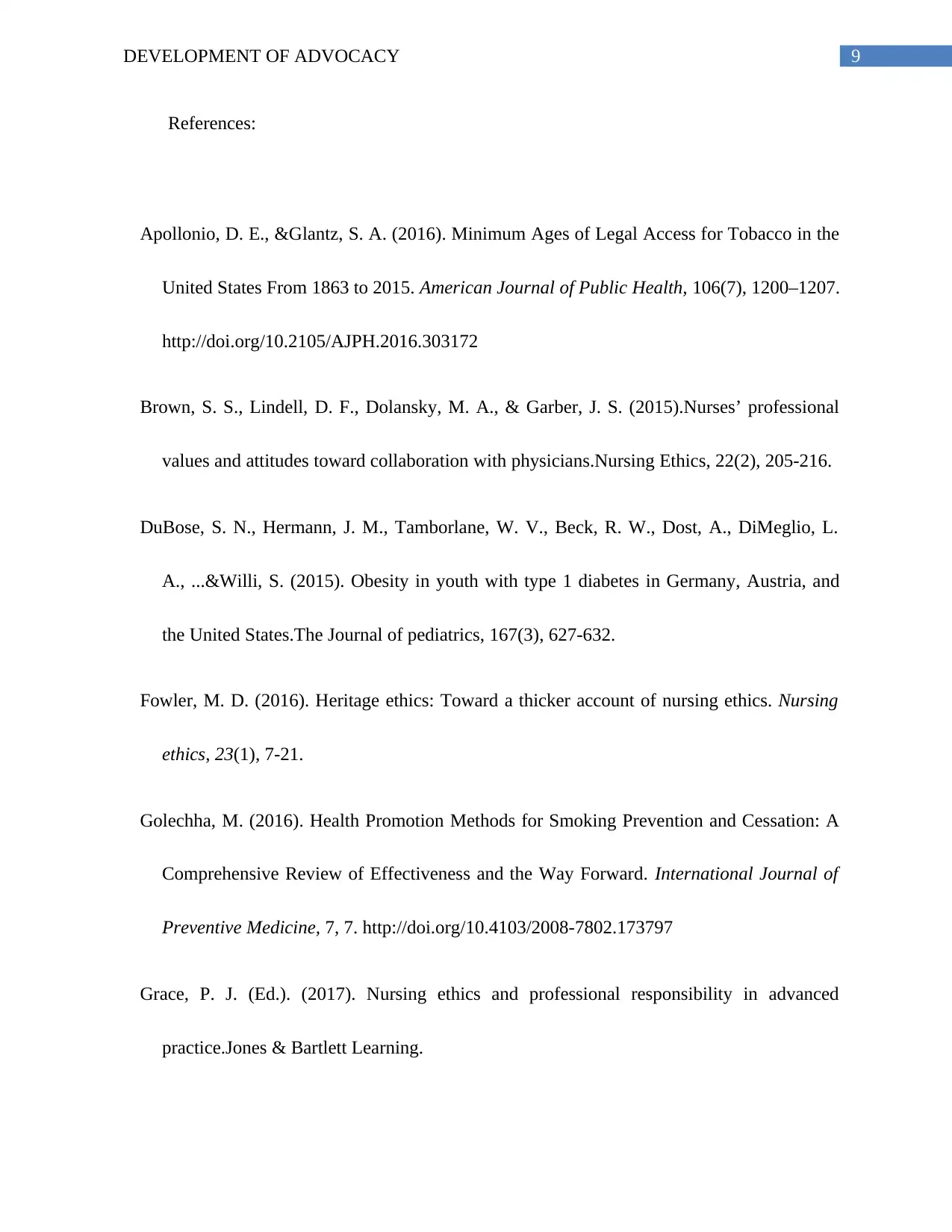
9DEVELOPMENT OF ADVOCACY
References:
Apollonio, D. E., &Glantz, S. A. (2016). Minimum Ages of Legal Access for Tobacco in the
United States From 1863 to 2015. American Journal of Public Health, 106(7), 1200–1207.
http://doi.org/10.2105/AJPH.2016.303172
Brown, S. S., Lindell, D. F., Dolansky, M. A., & Garber, J. S. (2015).Nurses’ professional
values and attitudes toward collaboration with physicians.Nursing Ethics, 22(2), 205-216.
DuBose, S. N., Hermann, J. M., Tamborlane, W. V., Beck, R. W., Dost, A., DiMeglio, L.
A., ...&Willi, S. (2015). Obesity in youth with type 1 diabetes in Germany, Austria, and
the United States.The Journal of pediatrics, 167(3), 627-632.
Fowler, M. D. (2016). Heritage ethics: Toward a thicker account of nursing ethics. Nursing
ethics, 23(1), 7-21.
Golechha, M. (2016). Health Promotion Methods for Smoking Prevention and Cessation: A
Comprehensive Review of Effectiveness and the Way Forward. International Journal of
Preventive Medicine, 7, 7. http://doi.org/10.4103/2008-7802.173797
Grace, P. J. (Ed.). (2017). Nursing ethics and professional responsibility in advanced
practice.Jones & Bartlett Learning.
References:
Apollonio, D. E., &Glantz, S. A. (2016). Minimum Ages of Legal Access for Tobacco in the
United States From 1863 to 2015. American Journal of Public Health, 106(7), 1200–1207.
http://doi.org/10.2105/AJPH.2016.303172
Brown, S. S., Lindell, D. F., Dolansky, M. A., & Garber, J. S. (2015).Nurses’ professional
values and attitudes toward collaboration with physicians.Nursing Ethics, 22(2), 205-216.
DuBose, S. N., Hermann, J. M., Tamborlane, W. V., Beck, R. W., Dost, A., DiMeglio, L.
A., ...&Willi, S. (2015). Obesity in youth with type 1 diabetes in Germany, Austria, and
the United States.The Journal of pediatrics, 167(3), 627-632.
Fowler, M. D. (2016). Heritage ethics: Toward a thicker account of nursing ethics. Nursing
ethics, 23(1), 7-21.
Golechha, M. (2016). Health Promotion Methods for Smoking Prevention and Cessation: A
Comprehensive Review of Effectiveness and the Way Forward. International Journal of
Preventive Medicine, 7, 7. http://doi.org/10.4103/2008-7802.173797
Grace, P. J. (Ed.). (2017). Nursing ethics and professional responsibility in advanced
practice.Jones & Bartlett Learning.
Paraphrase This Document
Need a fresh take? Get an instant paraphrase of this document with our AI Paraphraser
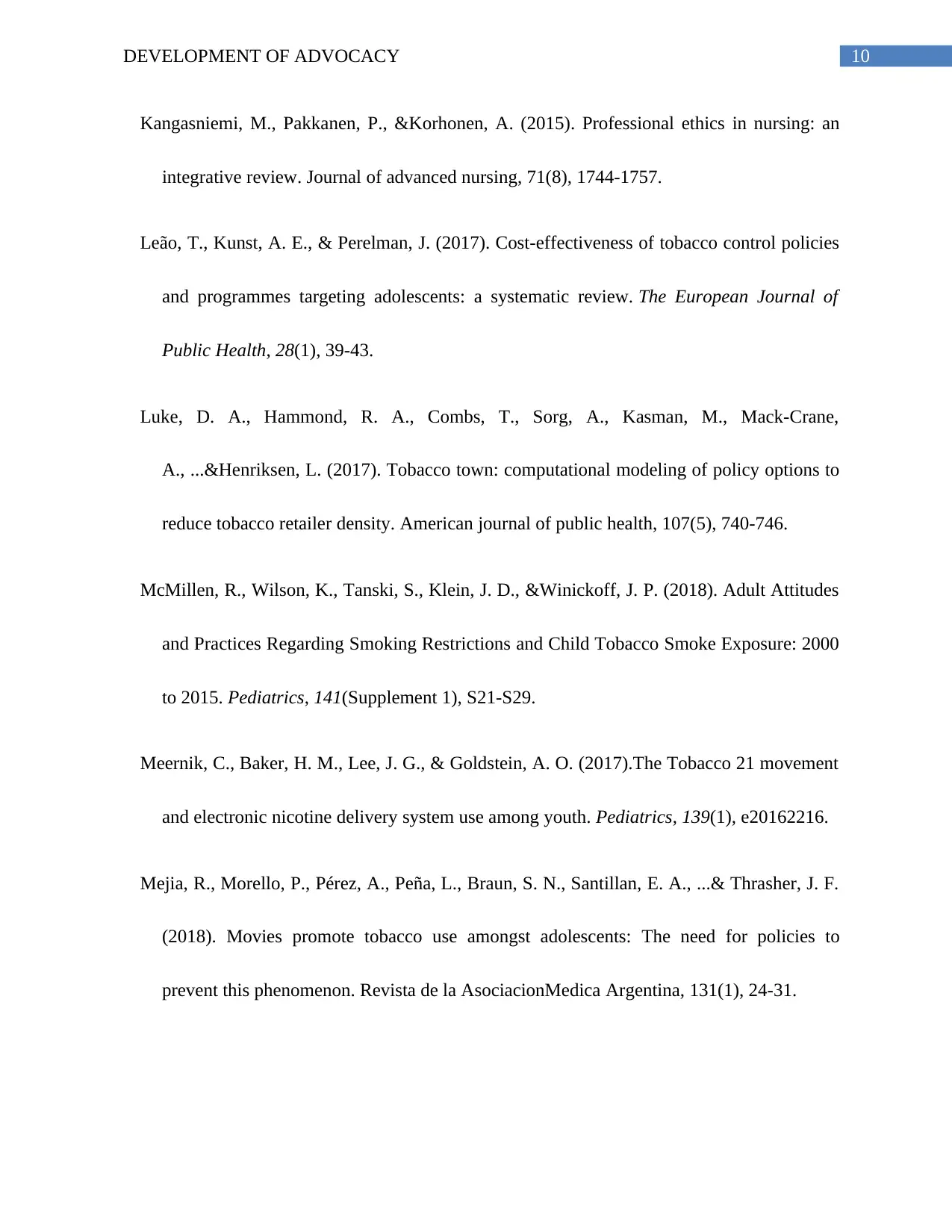
10DEVELOPMENT OF ADVOCACY
Kangasniemi, M., Pakkanen, P., &Korhonen, A. (2015). Professional ethics in nursing: an
integrative review. Journal of advanced nursing, 71(8), 1744-1757.
Leão, T., Kunst, A. E., & Perelman, J. (2017). Cost-effectiveness of tobacco control policies
and programmes targeting adolescents: a systematic review. The European Journal of
Public Health, 28(1), 39-43.
Luke, D. A., Hammond, R. A., Combs, T., Sorg, A., Kasman, M., Mack-Crane,
A., ...&Henriksen, L. (2017). Tobacco town: computational modeling of policy options to
reduce tobacco retailer density. American journal of public health, 107(5), 740-746.
McMillen, R., Wilson, K., Tanski, S., Klein, J. D., &Winickoff, J. P. (2018). Adult Attitudes
and Practices Regarding Smoking Restrictions and Child Tobacco Smoke Exposure: 2000
to 2015. Pediatrics, 141(Supplement 1), S21-S29.
Meernik, C., Baker, H. M., Lee, J. G., & Goldstein, A. O. (2017).The Tobacco 21 movement
and electronic nicotine delivery system use among youth. Pediatrics, 139(1), e20162216.
Mejia, R., Morello, P., Pérez, A., Peña, L., Braun, S. N., Santillan, E. A., ...& Thrasher, J. F.
(2018). Movies promote tobacco use amongst adolescents: The need for policies to
prevent this phenomenon. Revista de la AsociacionMedica Argentina, 131(1), 24-31.
Kangasniemi, M., Pakkanen, P., &Korhonen, A. (2015). Professional ethics in nursing: an
integrative review. Journal of advanced nursing, 71(8), 1744-1757.
Leão, T., Kunst, A. E., & Perelman, J. (2017). Cost-effectiveness of tobacco control policies
and programmes targeting adolescents: a systematic review. The European Journal of
Public Health, 28(1), 39-43.
Luke, D. A., Hammond, R. A., Combs, T., Sorg, A., Kasman, M., Mack-Crane,
A., ...&Henriksen, L. (2017). Tobacco town: computational modeling of policy options to
reduce tobacco retailer density. American journal of public health, 107(5), 740-746.
McMillen, R., Wilson, K., Tanski, S., Klein, J. D., &Winickoff, J. P. (2018). Adult Attitudes
and Practices Regarding Smoking Restrictions and Child Tobacco Smoke Exposure: 2000
to 2015. Pediatrics, 141(Supplement 1), S21-S29.
Meernik, C., Baker, H. M., Lee, J. G., & Goldstein, A. O. (2017).The Tobacco 21 movement
and electronic nicotine delivery system use among youth. Pediatrics, 139(1), e20162216.
Mejia, R., Morello, P., Pérez, A., Peña, L., Braun, S. N., Santillan, E. A., ...& Thrasher, J. F.
(2018). Movies promote tobacco use amongst adolescents: The need for policies to
prevent this phenomenon. Revista de la AsociacionMedica Argentina, 131(1), 24-31.
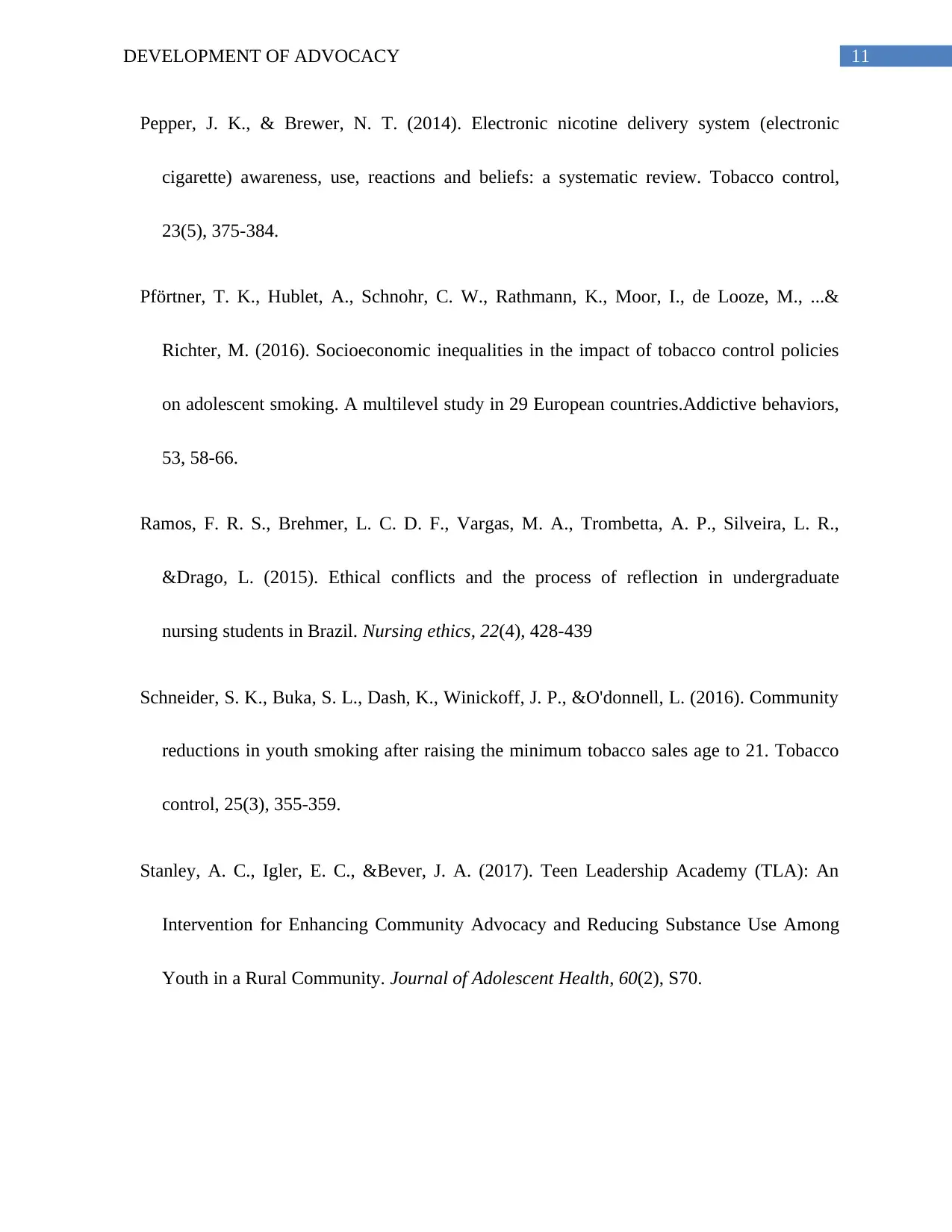
11DEVELOPMENT OF ADVOCACY
Pepper, J. K., & Brewer, N. T. (2014). Electronic nicotine delivery system (electronic
cigarette) awareness, use, reactions and beliefs: a systematic review. Tobacco control,
23(5), 375-384.
Pförtner, T. K., Hublet, A., Schnohr, C. W., Rathmann, K., Moor, I., de Looze, M., ...&
Richter, M. (2016). Socioeconomic inequalities in the impact of tobacco control policies
on adolescent smoking. A multilevel study in 29 European countries.Addictive behaviors,
53, 58-66.
Ramos, F. R. S., Brehmer, L. C. D. F., Vargas, M. A., Trombetta, A. P., Silveira, L. R.,
&Drago, L. (2015). Ethical conflicts and the process of reflection in undergraduate
nursing students in Brazil. Nursing ethics, 22(4), 428-439
Schneider, S. K., Buka, S. L., Dash, K., Winickoff, J. P., &O'donnell, L. (2016). Community
reductions in youth smoking after raising the minimum tobacco sales age to 21. Tobacco
control, 25(3), 355-359.
Stanley, A. C., Igler, E. C., &Bever, J. A. (2017). Teen Leadership Academy (TLA): An
Intervention for Enhancing Community Advocacy and Reducing Substance Use Among
Youth in a Rural Community. Journal of Adolescent Health, 60(2), S70.
Pepper, J. K., & Brewer, N. T. (2014). Electronic nicotine delivery system (electronic
cigarette) awareness, use, reactions and beliefs: a systematic review. Tobacco control,
23(5), 375-384.
Pförtner, T. K., Hublet, A., Schnohr, C. W., Rathmann, K., Moor, I., de Looze, M., ...&
Richter, M. (2016). Socioeconomic inequalities in the impact of tobacco control policies
on adolescent smoking. A multilevel study in 29 European countries.Addictive behaviors,
53, 58-66.
Ramos, F. R. S., Brehmer, L. C. D. F., Vargas, M. A., Trombetta, A. P., Silveira, L. R.,
&Drago, L. (2015). Ethical conflicts and the process of reflection in undergraduate
nursing students in Brazil. Nursing ethics, 22(4), 428-439
Schneider, S. K., Buka, S. L., Dash, K., Winickoff, J. P., &O'donnell, L. (2016). Community
reductions in youth smoking after raising the minimum tobacco sales age to 21. Tobacco
control, 25(3), 355-359.
Stanley, A. C., Igler, E. C., &Bever, J. A. (2017). Teen Leadership Academy (TLA): An
Intervention for Enhancing Community Advocacy and Reducing Substance Use Among
Youth in a Rural Community. Journal of Adolescent Health, 60(2), S70.
⊘ This is a preview!⊘
Do you want full access?
Subscribe today to unlock all pages.

Trusted by 1+ million students worldwide
1 out of 13
Your All-in-One AI-Powered Toolkit for Academic Success.
+13062052269
info@desklib.com
Available 24*7 on WhatsApp / Email
![[object Object]](/_next/static/media/star-bottom.7253800d.svg)
Unlock your academic potential
Copyright © 2020–2025 A2Z Services. All Rights Reserved. Developed and managed by ZUCOL.